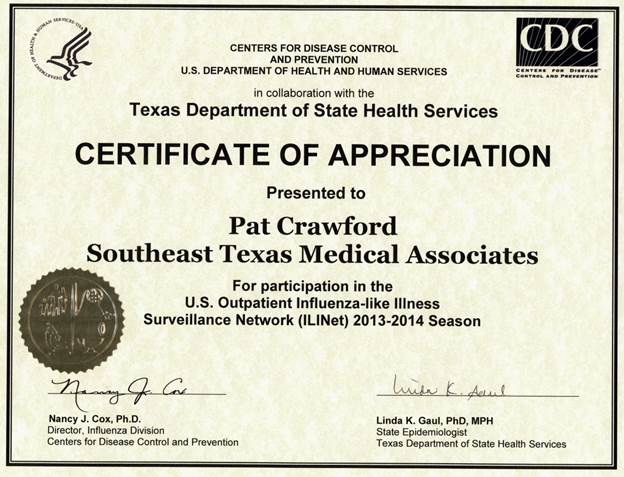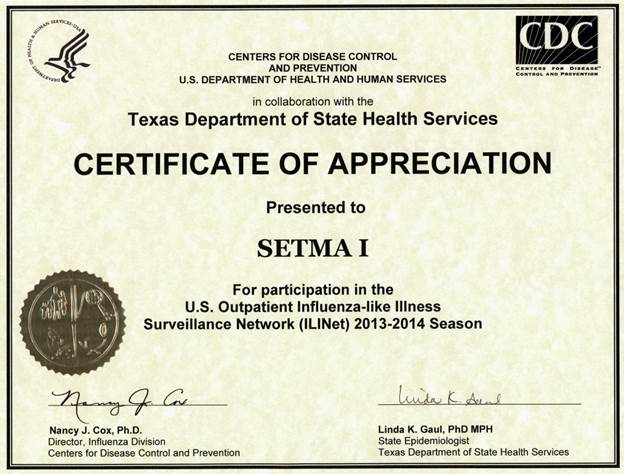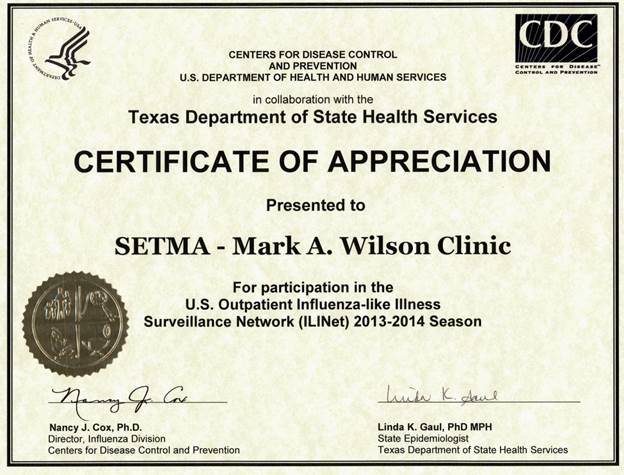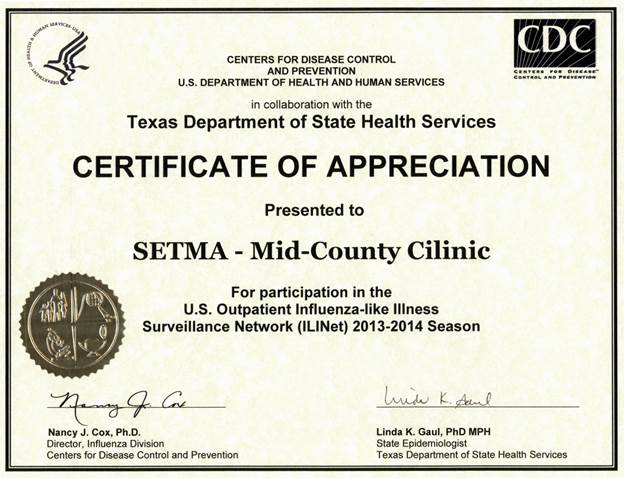|
Due to the Ebola outbreak, the critical role of the Centers for Disease Control in the health of the United States has come to the forefront of news and reporting. No one, who has taken the time to listen to the public statements by the Director of the CDC, Tom Frieden, MD, can not be impressed with the mission, passion and expertise of the CDC. This dramatic and critical function of the CDC is newsworthy.
Recently, Southeast Texas Medical Associates received a Certificate of Appreciation from the CDC; it states:
Centers for Disease Control
And Prevention
U.S. Department of Health and Human Services
In collaboration with the
Texas Department of State Health Services
CERTIFICATE of Appreciation
Presented to
Patricia Crawford
Jonathan Owens
James L. Holly, MD &
Southeast Texas Medical Associates
For Participation in the
U.S. Outpatient Influenza-like Illness
Surveillance Network (ILINet) 2013-2014 Season
| Nancy j. Cox, Ph.D. | Linda Gaul, PhD, MPH |
| Director, Influenza Division | State Epidemiologist |
| CDC Control and Prevention | Texas Department of State Health Services |
The certificate was accompanied by a letter from The Texas Department of State Health Services dated 7/31/14. It stated:
“We personally want to thank Southeast Texas Medical Associates, LLP for participating in the 2013-2014 U.S. Outpatient Influenza-like Illness Network (ILINet) Surveillance Program. This program would not exist without the work and dedication of its members. The data you provided this season allowed Texas to rank in the top two ILI surveillance networks in the country. Your participation is essential to that success. Therefore, it is an honor to present Southeast Texas medical ASSOCATCIASETE, LLP a 2013-2014 Certificate of Appreciation on behalf of the Centers for Disease Control and Prevention.
“Again, thank you for being part of the Influenza Surveillance Program.”
Sincerely,
| Robert Russin | Johnathan Ledbetter | Lesley Branan |
| ILINet Coordinator | State Influenza Surveillance Coordinator | IRID Team Leader |
At the same time, a communication was received from the Department of Health & Human Services. It stated:
‘To: U. S. Outpatient Influenza-like Illness Surveillance Network (ILINet) Providers:
“We would like to take this opportunity to thank you for your continued support of national influenza surveillance€¦Weekly ILI data are an essential component of seasonal and pandemic influenza surveillance and are used to detect unusual occurrences of ILI.
“With over 3,000 ILINet sties enrolled across the country during the 2013-14 season, and over half reporting regularly€¦ILINet is the most expansive national influenza surveillance system and relies upon many thousands of volunteer medical professionals across the country to be successful. While it is not possible to individually thank every person involved with the system, we greatly appreciate all your efforts and hope that every0one involved knows how valuable their participation is to the understanding of influenza activity each season in the United States.
“The 2013-14 influenza season peaked in late December with 2009 H1N1 viruses most commonly reported overall, but influenza B and influenza A (H3N2) viruses were also reported, particularly in March and April. The majority of all influenza viruses in respiration specimens sent to CDC for future testing were similar to the components of the 2013-14 Northern Hemisphere influenza vaccine€¦
“Rates of hospitalization were highest among those aged 65 years and over, but high rates of influenza-associated hospitalization were also seen among adults 50-64 years which is similar to what was reported during the 2009 H1NI pandemic, the last time H1N1 viruses were the predominant circulating influenza virus nationally. Among adults hospitalized with influenza the most frequent underlying medical conditions were obesity (43%, metabolic disorders (36%), and cardiovascular disease (34%). In children hospitalized with influenza 43%did not have known underlying medical conditions but 25% of children had underlying asthma or reactive airway disease.
“Thank you again for your commitment to influenza surveillance.”
Further observations
While SETMA is proud of its participation with the Texas State Department of Health and the CDC with routine HIV screening, which is the reason we were approached about the influenza-like surveillance, we all can learn from the material above. Who has the most danger of serious complications from influenza-like and influenza infections? Read the above again:
- The obese
- The elderly
- Those with cardiovascular disease
- Children with Asthma or reactive airway disease
8,000 people have died in Africa with Ebola. One African has died in the United States with Ebola. In 2012, a study co-authored by 9 members of the CDC Influenza Division, used an improved modeling approach which resulted in an estimated range of deaths from between 151,700 and 575,400 people who perished worldwide from 2009 H1N1 virus infection during the first year the virus circulated. A disproportionate number of deaths occurred in Southeast Asia and Africa, where access to prevention and treatment resources are more likely to be limited. Study authors hope that this work can be used not only to improve how influenza deaths are estimated, but also to improve the public health response during future pandemics in parts of the world that suffer more influenza-related deaths. Even in the United States up to 39,000 die of influenza in the United States annually. People are clamoring for a immunization against Ebola and they should. But we have effective vaccines for influenza, which kills 62 times more people annual than have died in this Ebola outbreak.
Surely, you would think, with this information, Americans are flocking to get their influenza immunization. Surely, more than 95% of Americans get their flu shots each year! Actually, the reality is that about 35% get a flu shot.
What would happen if everyone were vaccinated
The following from the CDC illustrates the value of vaccinations for whooping cough (Pertussis). By the way, Texas is having a pandemic of whooping cough. If you and/or your child has got your up dated tetanus immunization which includes diphtheria and Pertussis, you are protected. The following is a dramatic illustration of the value to the community, to your family and to you of immunizations.
We know that a disease that is apparently under control can suddenly return, because we have seen it happen, in countries like Japan, Australia, and Sweden. Here is an example from Japan. In 1974, about 80% of Japanese children were getting Pertussis (whooping cough) vaccine. That year there were only 393 cases of whooping cough in the entire country, and not a single pertussis-related death. Then immunization rates began to drop, until only about 10% of children were being vaccinated. In 1979, more than 13,000 people got whooping cough and 41 died. When routine vaccination was resumed, the disease numbers dropped again.
The chances of your child getting a case of measles or chickenpox or whooping cough might be quite low today. But vaccinations are not just for protecting ourselves, and are not just for today. They also protect the people around us (some of whom may be unable to get certain vaccines, or might have failed to respond to a vaccine, or might be susceptible for other reasons). And they also protect our children’s children and their children by keeping diseases that we have almost defeated from making a comeback. What would happen if we stopped vaccinations? We could soon find ourselves battling epidemics of diseases we thought we had conquered decades ago.
The first year, almost 19 years ago that SETMA got really serious about immunizations, we spent almost $1,000,000 buying the vaccines. That does not include the cost of administration. Preventing medicine is not inexpensive but it is lifesaving and in the long run will save you and your country a great deal of money.








|